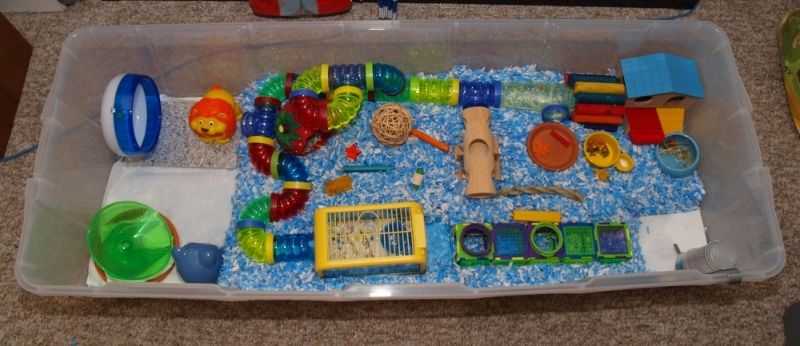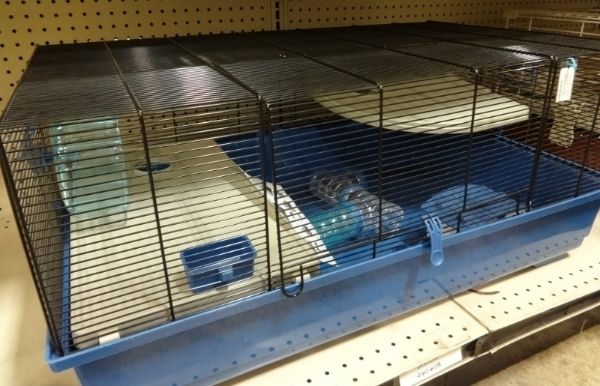Introduction
So you've done a bit of research, and you've decided that a hamster might be a good pet for you. Congratulations!  You're about to enter the wonderful world of hamster keeping.
You're about to enter the wonderful world of hamster keeping.
As you begin your in-depth research, one of the first questions you’re probably asking yourself is what type of cage you should keep it in.
Obviously, hamsters need to be kept in cages. However, we’ve taken to modifying the word “cage” to mean something a little more positive:
Contained Area for Great Exercise
Contained Area - A good cage should be secure and safe, with no obvious escape routes. This includes having a lid - while some cages can be okay without lids, this is generally not recommended unless the cage is extremely deep (over 36" of height).
Great Exercise - A good cage will provide lots of space for a hamster to exercise. It should provide at least 450 square inches of floor space (though more is better). To figure out floor space, simply measure the length and width of the bottom inside of the base of the cage (don’t use the dimensions on the box / lable!). Multiple those two numbers and that gives you floor space! The cage must also be able to accommodate at least 6" of bedding for burrowing.
Large Tanks

HoppingHammy’s 55-gallon tank
Yes, hamsters can be housed in fish and reptile tanks! And in fact, tanks are some of the best homes for hamsters out there. Tanks have the great benefit of requiring no assembly – they’re super-easy to set up. When used with a properly-fitted lid, they are secure, sturdy, and virtually escape proof.
Tanks are easy to find in many pet stores. If you can't find one to your liking, you may wish to seek out an aquarium supply shop, as they will likely have more choices.
Here are some good (and commonly available) tank sizes:
30-gallon breeder
40-gallon breeder
55-gallon
75-gallon
Larger tanks are certainly fine as well! If you have the space and money for a massive 100+ gallon aquarium, all the better! Your hamster will certainly appreciate the extra space!
Bin Cages

Taxonomist’s Christmas Tree Bin (lid not pictured)
Bin cages are a fantastic do-it-yourself option. A bin cage is a plastic storage tub modified with mesh windows (typically on the lid) for ventilation. Bin cages are a great budget option - they are inexpensive, lightweight, and easy to transport and clean. You can read more about bin cages by clicking here.
They do require some construction, and tools will be needed to build one. Wire mesh (hardware cloth) can be purchased at most home improvement stores. A sharp knife or Dremel will be needed to cut the plastic, and a drill will be useful for drilling holes to attach the mesh. Zip ties are screws can be used to secure the mesh to the plastic.
Some good bin cage options:
IRIS Christmas Tree Box
IKEA SAMLA 34 Gallon Box
Sterilite 116 Quart Ultra Latch Box
Sterilite 110 Quart Latch Box
IRIS 103 Quart Buckle-Up Box
IKEA Detolf

Taxonomist’s Detolf (lid not pictured)
The Detolf is a particular variety of not-quite-DIY cage. The Detolf is a tall glass display cabinet with a wooden top and base. However, when laid on its back and assembled without shelves or the door, it ends up being functionally identical to a large tank. It provides a good amount of space for a hamster and is quite reasonably priced for its size.
A Detolf does require assembly, and is best put together with at least 2 people. A DIY lid will need to be made, as the Detolf is shallow and easily escapable without one.
Large Rabbit and Guinea Pig Cages

A display guinea pig cage (picture taken at a pet store by Taxonomist)
Note: This cage, being a display, is obviously shown without the wire mesh that would be needed to make it hamster-safe!
While many hamster cages are indeed too small to house a hamster, some rabbit and guinea pig cages can actually make good homes for hamsters. The one "catch" is that the bar spacing on these cages is often too wide - while a rabbit or guinea pig could never get out, a tiny hamster could easily squeeze between the bars. Because of these, these cages need to have a layer of wire mesh added on top of the bars in order to close off the gaps.
Also, make sure to remove any wire grates on the floor of the habitat before use!
Here are just a few options for this type of cage. There are obviously many other choices. When looking at these types of cages, make sure that the advertised dimensions are at least 40" long x 15" wide. Because of the way the official on-the-box dimensions are taken (largest outside part of the cage), the actual living space at the base of the cage is much smaller than the given dimensions.
Grreat Choice Rabbitat
National Geographic Connectible Rabbit Small Animal Habitat
All Living Things Luxury Rabbit Cage
CareFresh Happy Guinea Pig Cage
WARE Living Room Rabbit Home
You & Me Living the Dream Small Animal Home
Hagen Living World Deluxe Habitat, XL
ZooZone 2 (top bars must be meshed)
"Premium" Hamster Cages

A display Kevin 82 Cage (picture taken at a pet store by Taxonomist)
There are a handful of hamster cages that are, believe it or not, actually large enough for hamsters. Many of these are only available in the UK, but some can be ordered into the US.
These cages are nice because most require no modification to be safe for a hamster. The major difference between these cages and the rabbit / guinea pig cages above is the bar spacing. Cages actually intended for animals like hamsters and mice will have much narrower bar spacing to prevent the animals from squeezing out. Many also come with additional tubes, shelves, and other accessories.
The following cages are hamster cages that are an acceptable size for a single hamster:
Savic Hamster Heaven
Alaska
Alexander
Kevin 82
Do-It-Yourself

HoppingHammy’s DIY cage (modified table frame)
Finally, the most flexible option available for hamster cages is the DIY type. DIY cages can either be furniture “hacks” (such as a cage made out of a bookshelf or wardrobe) or a cage made completely from scratch.
DIY cages can easily be among the biggest and best cages, however, they do require the most amount of work.















































